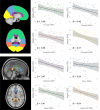White matter hyperintensity topography in Alzheimer's disease and links to cognition
- PMID: 34322985
- PMCID: PMC9292254
- DOI: 10.1002/alz.12410
White matter hyperintensity topography in Alzheimer's disease and links to cognition
Abstract
Introduction: White matter hyperintensities (WMH) are often described in Alzheimer's disease (AD), but their topography and specific relationships with cognition remain unclear.
Methods: Regional WMH were estimated in 54 cognitively impaired amyloid beta-positive AD (Aβpos-AD), compared to 40 cognitively unimpaired amyloid beta-negative older controls (Aβneg-controls) matched for vascular risk factors. The cross-sectional association between regional WMH volume and cognition was assessed within each group, controlling for cerebral amyloid burden, global cortical atrophy, and hippocampal atrophy.
Results: WMH volume was larger in Aβpos-AD compared to Aβneg-controls in all regions, with the greatest changes in the splenium of the corpus callosum (S-CC). In Aβpos-AD patients, larger total and regional WMH volume, especially in the S-CC, was strongly associated with decreased cognition.
Discussion: WMH specifically contribute to lower cognition in AD, independently from amyloid deposition and atrophy. This study emphasizes the clinical relevance of WMH in AD, especially posterior WMH, and most notably S-CC WMH.
Keywords: Alzheimer's disease; amyloid positron emission tomography; cognition; corpus callosum; executive functions; fluid-attenuated inversion recovery; magnetic resonance imaging; memory; splenium; white matter hyperintensities.
© 2021 The Authors. Alzheimer's & Dementia published by Wiley Periodicals LLC on behalf of Alzheimer's Association.
Conflict of interest statement
No conflicts of interest were reported by any author.
Figures


References
-
- Prins ND, Scheltens P. White matter hyperintensities, cognitive impairment and dementia: an update. Nat Rev Neurol. 2015;11:157‐165. - PubMed
-
- Kloppenborg RP, Nederkoorn PJ, Geerlings MI, van den Berg E. Presence and progression of white matter hyperintensities and cognition: a meta‐analysis. Neurology. 2014;82:2127‐2138. - PubMed
-
- Wang Y‐L, Chen W, Cai W‐J, et al. Associations of white matter hyperintensities with cognitive decline: a longitudinal study. J Alzheimers Dis. 2020;73:759‐768. - PubMed
Publication types
MeSH terms
Substances
LinkOut - more resources
Full Text Sources
Other Literature Sources
Medical
Research Materials

